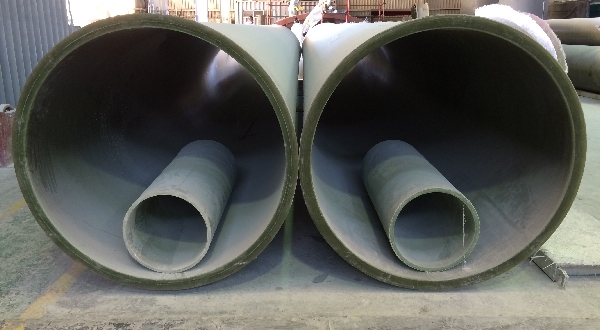 February 2015: Abrasive wear within the slurry piping systems occurs when hard particles are forced against, or slide along, the pipeline wall, causing continuous shearing and cutting that lead to loss of wall thickness. In harsher conditions, steel slurry pipes also need to be turned over at least every two months because pipes abrade more on one side than the other. In more extreme cases, these effects cause leaks, resulting in significant maintenance costs and downtime for pipe replacement. The effect of these issues can be dramatically reduced with the use of properly engineered abrasion-resistant GRP piping.
February 2015: Abrasive wear within the slurry piping systems occurs when hard particles are forced against, or slide along, the pipeline wall, causing continuous shearing and cutting that lead to loss of wall thickness. In harsher conditions, steel slurry pipes also need to be turned over at least every two months because pipes abrade more on one side than the other. In more extreme cases, these effects cause leaks, resulting in significant maintenance costs and downtime for pipe replacement. The effect of these issues can be dramatically reduced with the use of properly engineered abrasion-resistant GRP piping.
Pipelines handling high levels of suspended solids , irrespective of the material of construction, present engineers with a challenge. Abrasion and clogging due to sedimentation are the most common of these.
Says Roger Rush, CEO of IWC – “Abrasion-resistant GRP has a smooth inner surface and low roughness coefficient and this allows for higher pipeline flow velocities. The higher flow velocities ensure solids remain in suspension thereby preventing abrasion and clogging caused by sedimentation. GRP pipes also have low head losses reducing costs on energy required for pumping slurry. Furthermore GRP pipe can be designed to withstand abrasion that can occur externally, for example in piping used inside flue gas desulphurisation plants.”
GRP pipes are not just strong they are also light in weight. The weight of the pipe depends on the type of pipe chosen for the specific application, but they are generally about 1/8th the weight of steel making them easier to transport and install.
GRP pipes are multi-faceted and therefore can be used to transport coal, copper, iron, and phosphate concentrates and can also to transport mine tailings. The pipes can be customised to handle different abrasive materials (settling and non-settling slurries), temperatures and chemical attacks ensuring the integrity and longevity of the pipelines.
“It is also possible to construct GRP pipes with a thermoplastic or fluoroplastic internal layer, using materials such as Polypropylene, HDPE, PVC, PVDF, PFA or ECTFE. These pipes are structurally and mechanically identical to those of pure GRP pipes, but are able to withstand extreme abrasive environments,” says Rusch.
About IWC
IWC, originally founded in 1986 as Industrial Water Cooling, are the leaders in industrial cooling tower systems in Africa, offering fully integrated solutions, from industrial cooling towers to GRP.
IWC are at the forefront of GRP technology, delivering world-class solutions across all industries, from power generation and petrochemical; water and sanitation; to steel, aluminium and light industrial.
In addition to the GRP Pipe production plant based in Germiston IWC has a second state-of-the-art GRP manufacturing facility in Isando, Ekhuruleni equipped with two state-of-the-art filament winding machines capable of producing piping, tanks or vessels with a diameter ranging from 25 mm to 5000 mm with an overall maximum complete product mass of 20 tons, on the large winder.
IWC has undertaken projects across the SADC region, providing solutions in South Africa, Nambia, Zambia, Tunisia, Ghana, Mauritius, Malawi, Mozambique, Kenya, Uganda and Swaziland.
For more information visit: http://www.iwc.co.za